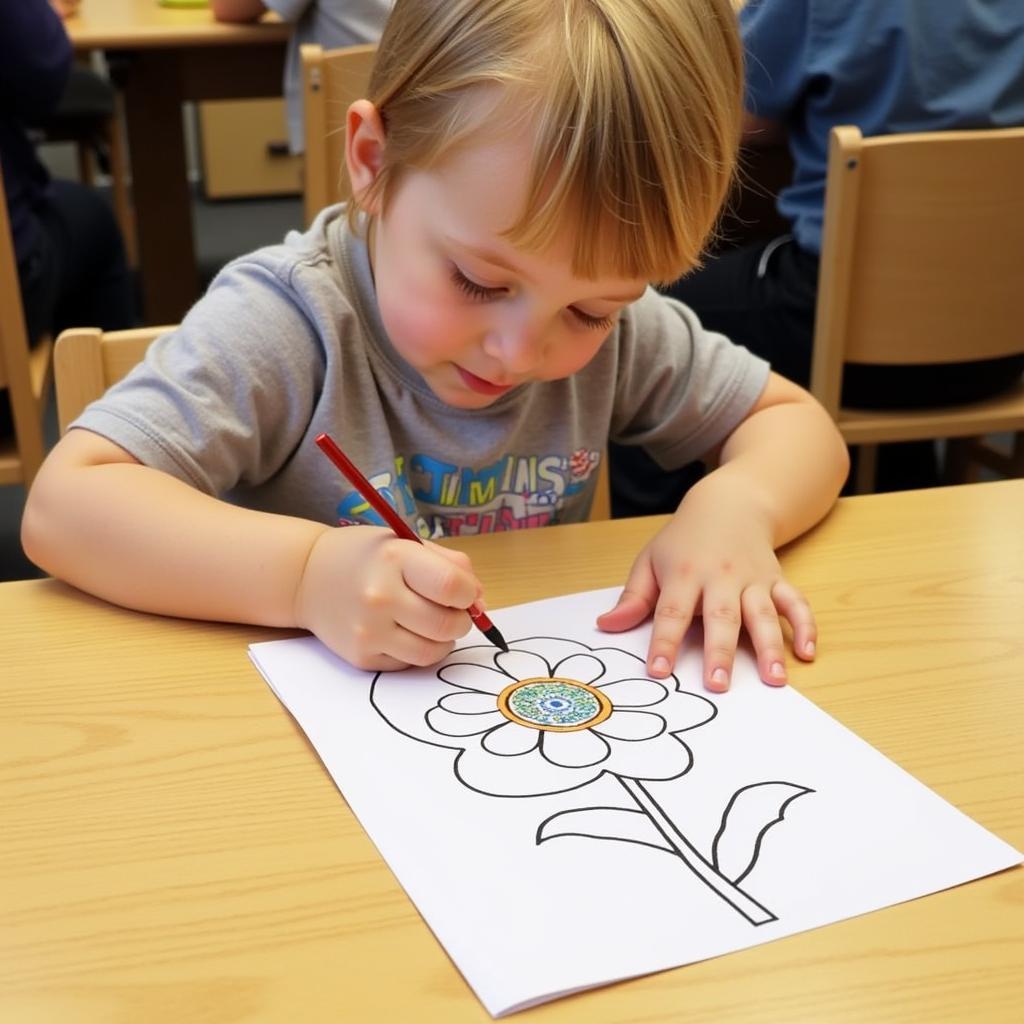Coloring is a beloved childhood activity that sparks creativity, develops fine motor skills, and provides hours of entertainment. But have you ever wondered, “When Do Kids Start Coloring?” The answer might surprise you! While there’s no magic age for crayons to become a child’s best friend, understanding the stages of development can help you nurture their artistic journey.
Scribbling: The First Steps into the World of Color (12-18 Months)
Around their first birthday, children discover the joy of making marks on paper. Armed with chunky crayons, they embark on a scribbling adventure, leaving trails of color in their wake. These early scribbles may seem random, but they represent a significant milestone in their development.
At this stage, it’s not about creating recognizable pictures but rather exploring cause and effect. The simple act of holding a crayon and seeing the color appear on paper is a thrilling discovery.
Expert Insight:
“Parents often underestimate the importance of scribbling,” says Dr. Emily Carter, a child development specialist. “It’s the foundation for later writing and drawing skills. Encourage your child’s early attempts by providing plenty of paper and crayons and praising their efforts.”
Controlled Scribbling and Emerging Shapes (18 Months – 2 Years)
As children approach two, their scribbles become more controlled. They might start imitating vertical and horizontal lines, and circular motions emerge. This newfound control reflects their developing fine motor skills and hand-eye coordination.
You might notice your child naming their scribbles, attributing meaning to the lines and shapes. A seemingly random scribble might become a “car” or a “house,” showcasing the blossoming of their imaginations.
Recognizing and Naming Colors (2-3 Years)
Between the ages of two and three, children begin to recognize and name basic colors. Coloring activities can be a fun and engaging way to reinforce color recognition.
Tip: Opt for coloring pages with simple designs and bold outlines, allowing them to focus on filling in the spaces with the correct colors. You can make it interactive by asking, “Can you color the sun yellow?” or “Where is the blue crayon?”
Early Coloring: Staying Within the Lines (3-4 Years)
By the time they reach preschool, many children have developed the fine motor control needed to color within the lines, though it’s still a work in progress. They take pride in their newfound abilities and enjoy the challenge of staying within the boundaries.
 Preschooler coloring a picture of a flower
Preschooler coloring a picture of a flower
This is an excellent time to introduce coloring books with themes that interest your child, whether it’s animals, dinosaurs, or their favorite cartoon characters.
Did you know? Coloring can also be a valuable tool for emotional expression. Encourage your child to choose colors based on their feelings or the mood of the picture.
Developing Precision and Creativity (5 Years and Beyond)
As children progress through school, their coloring skills continue to evolve. They develop greater precision, experiment with shading and blending, and use coloring as a medium for self-expression.
Don’t be surprised if your child starts creating their own drawings and coloring pages, letting their imagination run wild. This is a testament to their growing confidence and creativity.
Looking for fun and engaging coloring activities for your little ones? Check out our collection of printable coloring pages: may coloring page printable
Conclusion: Nurturing a Lifelong Love for Color
Coloring is more than just a fun pastime. It’s a journey of discovery that fosters creativity, develops essential skills, and provides a platform for self-expression. From the first scribbles to intricate masterpieces, each stage is a celebration of your child’s developing abilities.
By providing the right tools, encouragement, and a nurturing environment, you can help your child embrace the joy of coloring and cultivate a lifelong love for the world of art.
FAQs
1. What are the benefits of coloring for kids?
Coloring offers numerous benefits for children, including improved fine motor skills, enhanced hand-eye coordination, color recognition, and boosted creativity. It also promotes focus, patience, and self-expression.
2. What types of crayons are best for toddlers?
Chunky crayons, specifically designed for small hands, are ideal for toddlers. They are easy to grip and less prone to breaking.
3. How can I encourage my child to color within the lines?
Start with coloring pages that have simple designs and bold outlines. You can also use a highlighter to trace the lines beforehand, providing a clear boundary for them to follow.
4. Can coloring help my child’s emotional development?
Yes, coloring can be a valuable tool for emotional expression. Encourage your child to choose colors based on their feelings or the mood of the picture. Talk about the colors they use and what they might represent.
5. What if my child isn’t interested in coloring?
Every child develops at their own pace. Don’t force it. Instead, try offering a variety of art materials, such as paint, clay, or stickers, and allow them to explore different textures and mediums.
Need more inspiration for colorful creations? Learn how to dye noodles with food coloring for a fun and edible art project: how to dye noodles with food coloring. Or discover the vibrant world of “How to Train Your Dragon” with our collection of free printable coloring pages: how to train your dragon toothless coloring pages.
Have questions about choosing the right coloring materials for your child’s age or exploring different coloring techniques? Contact us at Phone Number: 0373298888, Email: [email protected] Or visit us at: 86 Cầu Giấy, Hà Nội. Our customer support team is available 24/7 to assist you.
